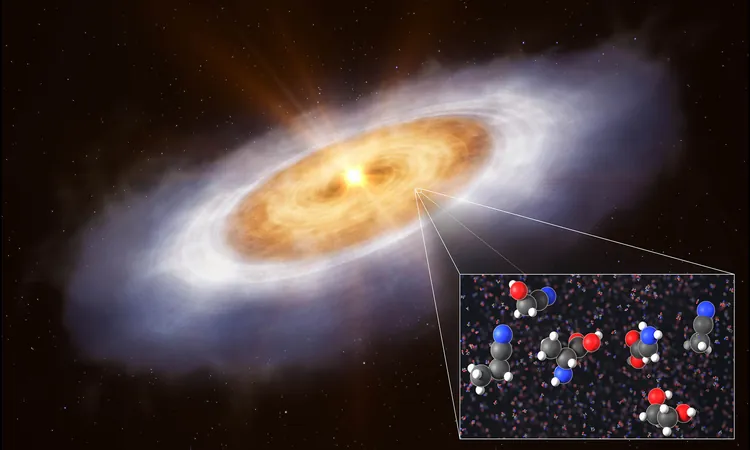
Unlocking the Secrets of Life's Origins: Complex Molecules Discovered Around a Young Star!
2025-07-29
Author: Mei
A Groundbreaking Discovery in the Cosmic Nursery
Astrophysicists are buzzing with excitement after a remarkable finding at the young star V883 Orionis, located a staggering 1,300 light-years away in the Orion constellation. Recent observations have unveiled a treasure trove of complex organic molecules swirling in its protoplanetary disk—a gaseous cloud where new planets are being born.
The Building Blocks of Life?
Among the 17 molecular species identified by the research team, led by Abubakar Fadul from the Max Planck Institute for Astronomy, are ethylene glycol and glycolonitrile. These compounds may serve as crucial precursors for sugars and amino acids—key ingredients for life as we know it.
How These Molecules Came to Be
V883 Orionis is currently undergoing dramatic flaring, which heats its disk and liberates frozen chemicals originally trapped in dust grains. Using the Atacama Large Millimeter/submillimeter Array (ALMA) in Chile, the team detected radio signals revealing the existence of these organic molecules under temperatures around 570°F (300°C) for ethylene glycol and 190°F (88°C) for glycolonitrile. This is evidence of a continuous line of chemical complexity stretching from interstellar space to fully formed planetary systems.
A Cosmic Recipe for Life
In the heart of this cosmic nursery, ethylene glycol is released into space under mild warmth, similar to how sunlight lifts cometary materials. Glycolonitrile has also been found in dense interstellar clouds, suggesting its resilience in harsh environments—an encouraging sign for life-formation possibilities on emerging planets.
Linking Cosmic Chemistry to Life
The presence of both precursors raises tantalizing possibilities: could they migrate onto budding planetary bodies, forming the backbone of biological chemistry? The discovery indicates that complex molecules might not only survive but could flourish even during the chaotic formation of new worlds.
Ancient Insights from Comets
Our own solar system’s comets present striking parallels. For instance, recent findings from the Rosetta mission revealed glycine—an amino acid—in a comet. Such discoveries suggest that icy bodies may act as time capsules, carrying life's fundamental building blocks across the cosmos for billions of years.
Future Questions and Exploration
Not everything is clear yet. Current models struggle to account for the abundance of glycolonitrile, and questions persist regarding the behavior of other organic compounds like glycolaldehyde. A deeper investigation with enhanced technology is necessary to unravel these mysteries.
The Path Ahead for V883 Orionis
The research team plans to monitor V883 Orionis as it evolves, hoping to compare hot and cold chemical environments within the same protoplanetary disk. This could shed light on which organic molecules persist and which fade as conditions change.
Implications for the Universe
If organic molecules are abundant during planet formation, young worlds across the galaxy may enter their own life-stories equipped with chemical riches. Meteorites, too, have shown evidence of genetic material-building blocks. This exciting research implies that all planetary systems may share a common thread intertwined with life itself.
A New Perspective on Life's Origins
The findings from V883 Orionis have a profound impact on our understanding of life's chemical preparation throughout the universe. This study not only marches forward the search for extraterrestrial life but also invites us to reconsider the cosmic ingredients necessary for life's emergence.


 Brasil (PT)
Brasil (PT)
 Canada (EN)
Canada (EN)
 Chile (ES)
Chile (ES)
 Česko (CS)
Česko (CS)
 대한민국 (KO)
대한민국 (KO)
 España (ES)
España (ES)
 France (FR)
France (FR)
 Hong Kong (EN)
Hong Kong (EN)
 Italia (IT)
Italia (IT)
 日本 (JA)
日本 (JA)
 Magyarország (HU)
Magyarország (HU)
 Norge (NO)
Norge (NO)
 Polska (PL)
Polska (PL)
 Schweiz (DE)
Schweiz (DE)
 Singapore (EN)
Singapore (EN)
 Sverige (SV)
Sverige (SV)
 Suomi (FI)
Suomi (FI)
 Türkiye (TR)
Türkiye (TR)
 الإمارات العربية المتحدة (AR)
الإمارات العربية المتحدة (AR)